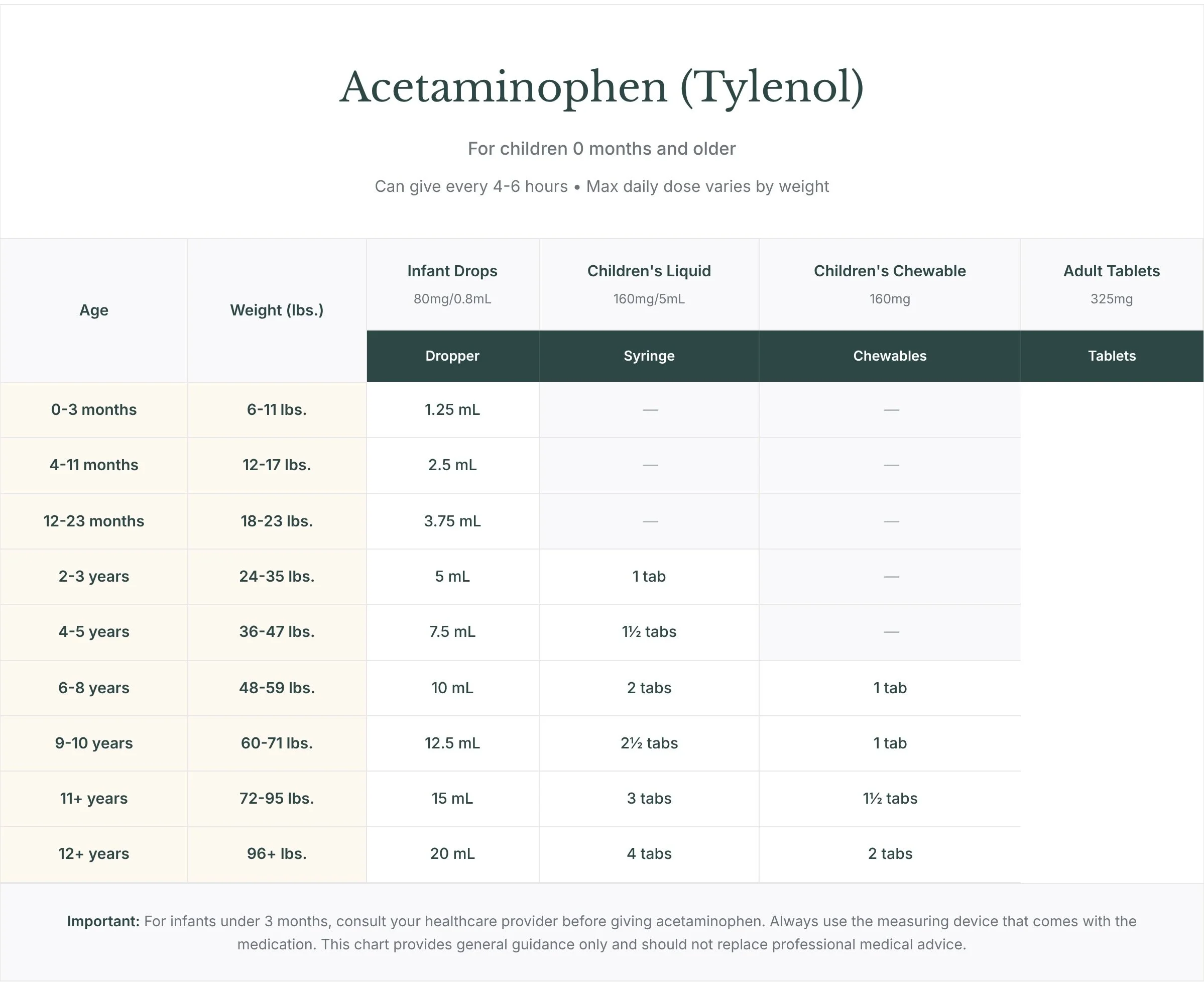Safe Tylenol (Acetaminophen) Dosage Calculator for Children & Infants
Tylenol (acetaminophen) is the most commonly used medication for children to reduce fever and relieve pain. While it is safe and effective, proper dosing is critical—too little may not work, and too much can be harmful.
This children’s Tylenol dosage chart is based on trusted pediatric guidelines of 10–15 mg/kg per dose. It gives parents a simple way to calculate safe amounts, while reminding you to always consult your healthcare provider for personalized guidance.
👉 If you’ve been contacted by Nest or your health plan, or think you and your family might be eligible, call us today at 866-222-NEST (6378).
How to use our Tylenol dosage chart
Follow these steps to safely use the dosage calculator:
Weigh your child on a reliable scale (remove heavy clothes or diapers for accuracy).
Find their age and weight range in the chart.
Check the correct formulation (infant drops, children’s liquid, chewables, etc.).
Follow frequency rules: every 4–6 hours as needed, up to 5 doses in 24 hours.
Always use the measuring device that comes with your medication.
Double-check daily limits: never exceed the maximum mg per day based on your child’s weight.
For infants under 3 months, talk with your doctor before giving any Tylenol.
⚠️ These are general guidelines, confirm dosing with your child’s provider, especially if your child is taking other medications.
When to give Tylenol to your child
Tylenol may be used for:
✅ Fever reduction
✅ Pain relief (headaches, earaches, teething, sore throat, minor injuries)
✅ Relief after vaccinations
✅ Cold and flu discomfort
Unlike some pain relievers, acetaminophen is safe from birth (with proper dosing).
Do not give Tylenol if your child has certain liver conditions or if symptoms suggest something more serious—always contact your pediatrician in these cases.
Understanding pediatric Tylenol dosing guidelines
Standard dose: 10–15 mg/kg per dose
Most effective: 15 mg/kg per dose
Timing: Every 4–6 hours as needed
Maximum: 5 doses in 24 hours
Daily limit: Do not exceed the mg maximum for your child’s weight
👉 Weight-based dosing is more accurate than age-based. Stop giving Tylenol if your child’s fever or pain does not improve within 3 days and consult your healthcare provider.
Different acetaminophen formulations for children
Infant drops: Highly concentrated, small volume for infants
Children’s liquid: Lower concentration, larger volume, easier for toddlers and young children
Chewable tablets: For children 2+ years who can chew safely
Dissolving tablets: Great alternative for kids who resist liquids
Suppositories: Useful if your child is vomiting or refuses oral medicine
⚠️ Always check the label carefully and use only pediatric formulations. Never substitute adult-strength Tylenol for children.
Acetaminophen safety and overdose prevention
✅ Acetaminophen is very safe when dosed correctly.
✅ The biggest risk is exceeding maximum daily doses.
✅ Check all medicines: many cold/flu products already contain acetaminophen.
✅ Use only the included measuring cup, syringe, or dropper.
⚠️ Signs of overdose include nausea, vomiting, confusion, abdominal pain, or extreme sleepiness. Seek emergency help immediately if suspected.
Combining Tylenol with other medications
With ibuprofen: Sometimes alternated safely—ask your doctor for timing.
With cold medications: Watch for hidden acetaminophen to avoid double dosing.
With prescriptions: Always confirm with your provider.
With other fever reducers: Do not combine unless instructed by a healthcare professional.
Some pediatricians recommend alternating Tylenol and ibuprofen for persistent fevers—follow a clear schedule from your provider if doing so.
When to contact your healthcare provider
Call your doctor if:
Your infant under 3 months has a fever
A fever above 104°F does not improve
A fever lasts more than 3 days
Your child shows signs of severe illness (difficulty breathing, dehydration, lethargy)
You suspect an overdose
You are unsure about mixing Tylenol with another medication
Persistent symptoms often mean a condition requiring medical evaluation.
FAQs about Tylenol use in children
Can I give Tylenol to my newborn?
Yes, but always confirm the dose with your provider.
How long does it take to work?
Usually 30–60 minutes.
What if my child spits out or vomits the dose?
If it happens right away, you may repeat it. If it happens repeatedly, call your pediatrician.
Is it safe to give Tylenol every day?
Not for long-term use, contact your doctor if your child needs daily medication.
Can Tylenol cause liver damage?
Not when used correctly. The risk comes from overdose or giving too frequently.
What’s the difference between infant drops and children’s liquid?
Infant drops are more concentrated. Always check labels and dosing carefully.
Can I alternate Tylenol and ibuprofen?
Yes, sometimes, but only under medical guidance with a clear dosing schedule.
Expert pediatric care with Nest Health
At Nest Health, our providers support families with in-home pediatric care, including safe medication guidance. We help parents feel confident when managing fevers, pain, or discomfort in children.
With Nest, expert care comes directly to your home, when you need it most.
👉 If you’ve been contacted by Nest or your health plan, or think you and your family might be eligible, call us today at 866-222-NEST (6378).
⚠️ Safety Disclaimer
This dosage calculator is for general guidance only.
Always follow your healthcare provider’s instructions
Individual children may require different dosing
Do not exceed daily maximums
Seek immediate care for severe symptoms or suspected overdose
This tool does not replace professional medical advice


